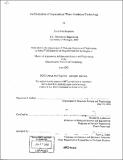| dc.contributor.advisor | Ronald M. Latanision. | en_US |
| dc.contributor.author | Kupferer, David Neil, 1979- | en_US |
| dc.contributor.other | Massachusetts Institute of Technology. Dept. of Materials Science and Engineering. | en_US |
| dc.date.accessioned | 2005-08-23T20:22:14Z | |
| dc.date.available | 2005-08-23T20:22:14Z | |
| dc.date.copyright | 2002 | en_US |
| dc.date.issued | 2002 | en_US |
| dc.identifier.uri | http://hdl.handle.net/1721.1/8462 | |
| dc.description | Thesis (M.Eng.)--Massachusetts Institute of Technology, Dept. of Materials Science and Engineering, 2002. | en_US |
| dc.description | Includes bibliographical references (p. 45-46). | en_US |
| dc.description.abstract | Water exists in a supercritical state above its supercritical temperature, 374.2 °C, and pressure, 22.1 :MPa. When organic waste is placed in a reactor with supercritical water, the vaporization, oxidation, and destruction of the organic compounds is achievable in a short time span, typically less than one minute. This process has come to be known as Supercritical Water Oxidation (SCWO). Potential applications for this developing technology include: military wastes, such as chemical agents and munitions, shipboard waste, industrial wastes, such as paper mill effluent and pharmaceutical waste, and municipal waste. It is a common belief among those involved in the development of SCWO that other niche applications will surface with time. Many SCWO reactor designs have been developed to meet the needs of these varied applications. The two basic designs are the tubular and vessel design, to which many technical augmentations have been made to develop reactor designs such as the "transpiring wall reactor" and the "deep-well" reactor. The primary challenges that are inhibiting the rapid commercialization of SCWO include both engineering issues, such as corrosion, solids handling and scaling, and non-engineering issues, such as economics and public perception. Many competitive technologies exist for the treatment of hazardous wastes. The two oldest technologies that we currently utilized in the majority of waste management applications are landfilling and incineration. Other technologies being developed and improved alongside of SCWO include: bio-treatment, wet air oxidation, plasma arc treatment, and adsorption. The international market for waste management and disposal is large, and as the policies and laws of the world become more environmentally protective, the development of alternative waste destruction technologies will become imperative. This paper explores the potential of SCWO to stake a claim in the future of daily waste management practices. | en_US |
| dc.description.statementofresponsibility | by David Neil Kupferer. | en_US |
| dc.format.extent | 57 p. | en_US |
| dc.format.extent | 5785661 bytes | |
| dc.format.extent | 5785421 bytes | |
| dc.format.mimetype | application/pdf | |
| dc.format.mimetype | application/pdf | |
| dc.language.iso | eng | en_US |
| dc.publisher | Massachusetts Institute of Technology | en_US |
| dc.rights | M.I.T. theses are protected by copyright. They may be viewed from this source for any purpose, but reproduction or distribution in any format is prohibited without written permission. See provided URL for inquiries about permission. | en_US |
| dc.rights.uri | http://dspace.mit.edu/handle/1721.1/7582 | |
| dc.subject | Materials Science and Engineering. | en_US |
| dc.title | An evaluation of supercritical water oxidation technology | en_US |
| dc.type | Thesis | en_US |
| dc.description.degree | M.Eng. | en_US |
| dc.contributor.department | Massachusetts Institute of Technology. Department of Materials Science and Engineering | |
| dc.identifier.oclc | 50680390 | en_US |
